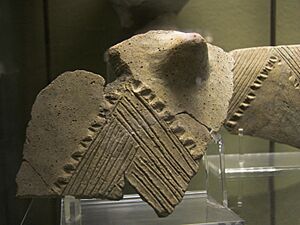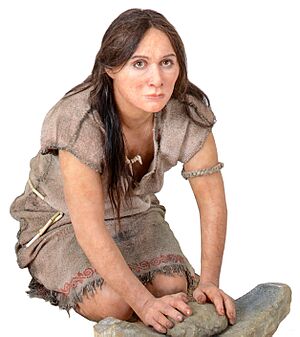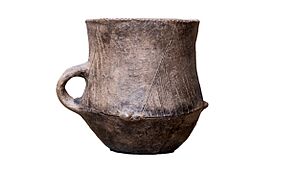Neolithic Italy facts for kids
- Further information: Prehistoric Italy#Neolithic
Neolithic Italy is about a time long ago, from around 6000 BCE to 3500-3000 BCE. This was when new ideas about farming and living reached the Italian peninsula and nearby islands from the east. This big change is called the Neolithic Revolution. It ended when people started using metallurgy (working with metals).
Contents
Early Neolithic: New Ways of Life Arrive
How Farming Came to Italy
In the western part of the Mediterranean Sea, farming first arrived by sea. People brought a special kind of pottery called Cardium pottery. It had cool patterns made by pressing a shell (from a mollusk called Cardium) into the wet clay. This pottery spread along the coasts from Liguria to southern France and Spain.
Another wave of new ideas went up the Danube River into Central Europe. These people made Linear Pottery, which had different line patterns. When these new farmers met the people already living in Europe (called Mesolithic communities), many different local styles of pottery and ways of life appeared.
In Southern Italy, the Cardium pottery culture spread between 6000 BCE and 5000 BCE. It was especially common in areas like Tavoliere delle Puglie, Irpinia, and Basilicata. From there, it moved north and to the Tyrrhenian coast. In Sicily, the changes were a bit slower, with more connections to the local Mesolithic people. The island of Lipari was settled around 5000 BCE by people from Sicily. They came to use the island's obsidian deposits. Obsidian is a natural glass used to make sharp tools.
In Central Italy, the Apennines mountains created different cultures on the Tyrrhenian and Adriatic sides. Various groups lived there, sometimes overlapping. In Sardinia, people started using obsidian from Monte Arci very early. Neolithic cultures, with their impressed pottery, arrived there around 6000 BCE.
In Northern Italy, a type of Cardium pottery became popular on the Ligurian coast around 6000 BCE. In Northwest Italy, the new ways of life came from the Ligurian impressed pottery. In Romagna, a different kind of impressed pottery from Abruzzo and Marche spread around 5500 BCE. By the end of that millennium, the Po Valley had many different cultures, all known for their pottery decorations. Around 5000 BCE, a new culture called the "Square Mouthed Vases" culture became widespread from Liguria to Veneto.
Middle Neolithic: Developing Cultures

During the Middle Neolithic period, different archaeological cultures developed across Italy. These cultures are named after the places where their unique tools and pottery were first found. For example, the Stentinello culture was important in Sicily. In Sardinia, the Bonu Ighinu culture was present. In Northern Italy, the Square Mouthed Vases culture continued to be important. These cultures show how people adapted and created their own styles in different regions.
Late Neolithic: More Changes
In the Late Neolithic, even more distinct cultures emerged. In Sicily, the Diana culture became well-known. In Central Italy, the Ripoli culture was significant. Sardinia saw the rise of cultures like San Ciriaco culture, Arzachena culture, and Ozieri culture. Northern Italy had the Lagozza culture and a Ligurian version of the Chassey culture. These different groups show how diverse and rich the Neolithic period was in Italy.
Economy: How People Lived and Traded

From the middle of the sixth millennium BCE, Neolithic groups in Italy started using local resources more widely. They learned to domesticate wild animals like cattle and pigs. This led to a "mixed" economy. People farmed, using tools like mills, grinders, and sickles. They also raised animals. Most settlements were permanent, meaning people stayed in one place. However, hunting, fishing, and gathering shellfish were still important ways to get food.
Obsidian was a very important material for making tools. It played a big role in trade among Neolithic communities. The main places to find obsidian were in Sardinia (Monte Arci), Lipari, Pantelleria, and Palmarola. From these places, obsidian was traded not only within the Italian peninsula but also to Southern France and North Africa.
Religion: New Beliefs
Late in the Neolithic period, new religious ideas appeared in Sardinia and Val d'Aosta. These ideas were connected to the introduction of megalithism. Megaliths are huge stone structures, often used for burials or religious ceremonies. These ideas likely came from the west.
See also
- Neolithic Europe
- Pre-Nuragic Sardinia
- Prehistoric Italy




